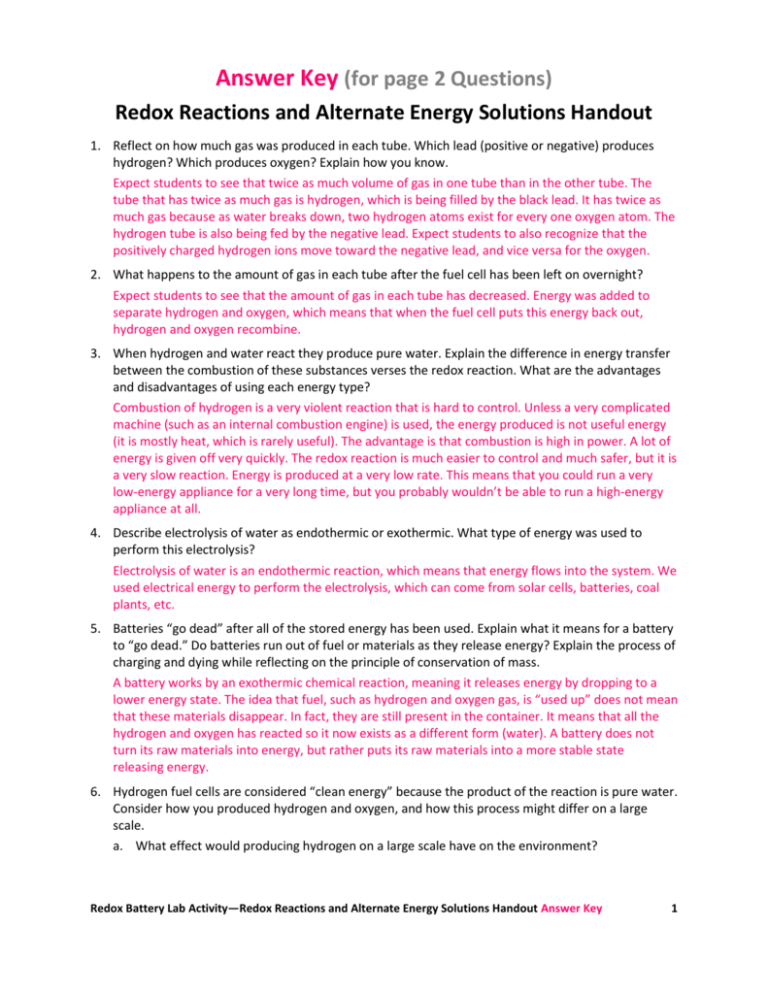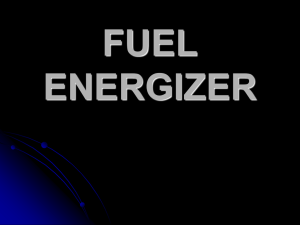Redox Reactions and Alternate Energy Solutions Handout Answer
advertisement

Answer Key (for page 2 Questions) Redox Reactions and Alternate Energy Solutions Handout 1. Reflect on how much gas was produced in each tube. Which lead (positive or negative) produces hydrogen? Which produces oxygen? Explain how you know. Expect students to see that twice as much volume of gas in one tube than in the other tube. The tube that has twice as much gas is hydrogen, which is being filled by the black lead. It has twice as much gas because as water breaks down, two hydrogen atoms exist for every one oxygen atom. The hydrogen tube is also being fed by the negative lead. Expect students to also recognize that the positively charged hydrogen ions move toward the negative lead, and vice versa for the oxygen. 2. What happens to the amount of gas in each tube after the fuel cell has been left on overnight? Expect students to see that the amount of gas in each tube has decreased. Energy was added to separate hydrogen and oxygen, which means that when the fuel cell puts this energy back out, hydrogen and oxygen recombine. 3. When hydrogen and water react they produce pure water. Explain the difference in energy transfer between the combustion of these substances verses the redox reaction. What are the advantages and disadvantages of using each energy type? Combustion of hydrogen is a very violent reaction that is hard to control. Unless a very complicated machine (such as an internal combustion engine) is used, the energy produced is not useful energy (it is mostly heat, which is rarely useful). The advantage is that combustion is high in power. A lot of energy is given off very quickly. The redox reaction is much easier to control and much safer, but it is a very slow reaction. Energy is produced at a very low rate. This means that you could run a very low-energy appliance for a very long time, but you probably wouldn’t be able to run a high-energy appliance at all. 4. Describe electrolysis of water as endothermic or exothermic. What type of energy was used to perform this electrolysis? Electrolysis of water is an endothermic reaction, which means that energy flows into the system. We used electrical energy to perform the electrolysis, which can come from solar cells, batteries, coal plants, etc. 5. Batteries “go dead” after all of the stored energy has been used. Explain what it means for a battery to “go dead.” Do batteries run out of fuel or materials as they release energy? Explain the process of charging and dying while reflecting on the principle of conservation of mass. A battery works by an exothermic chemical reaction, meaning it releases energy by dropping to a lower energy state. The idea that fuel, such as hydrogen and oxygen gas, is “used up” does not mean that these materials disappear. In fact, they are still present in the container. It means that all the hydrogen and oxygen has reacted so it now exists as a different form (water). A battery does not turn its raw materials into energy, but rather puts its raw materials into a more stable state releasing energy. 6. Hydrogen fuel cells are considered “clean energy” because the product of the reaction is pure water. Consider how you produced hydrogen and oxygen, and how this process might differ on a large scale. a. What effect would producing hydrogen on a large scale have on the environment? Redox Battery Lab Activity—Redox Reactions and Alternate Energy Solutions Handout Answer Key 1 Expect students to see how slowly hydrogen is produced using solar panels. Expect them to further recognize that to produce hydrogen on a large scale they would need a more powerful energy source or a more efficient way of producing it. b. Under what circumstances could hydrogen fuel NOT be considered clean energy? Expect students to recognize that their hydrogen fuel cells are only as clean as the energy used to separate the hydrogen and oxygen. If solar panels are used, the energy is completely clean. However, if produced at a large scale using coal or fossil fuels to generate the energy, it would actually be LESS clean because energy would be lost converting the energy stored in fossil fuel bonds to a hydrogen fuel cell. 7. Oxygen is an extremely reactive gas. What would happen if a piece of iron were left in the oxygen collection container? What effect would this have on the cells’ ability to store and release energy? What decisions must an engineer make in order to make sure that a fuel source is “rechargeable”? Oxygen would react with the iron, which means that less oxygen would be available to react with the hydrogen. If the oxygen runs out before the hydrogen, then the reaction stops, which means no more energy is produced. Hence, storage material can affect battery efficiency. An engineer must make sure that any reaction taking place in the fuel cell is reversible. If the reaction is not reversible, then the fuel cell will not be able to store energy more than one cycle. 8. Use your answer to question 6 to predict why older rechargeable batteries lose their ability to charge over time, especially if not completely discharged. See if students get to the idea that a battery has some material that one of the components can react with. When left charged for too long or not regularly deeply discharged, the raw materials in a battery reacts to create crystals. These crystals reduce the amount of non-reacted material. 9. Does the amount of gas in the tube affect how much voltage is produced? Explain your answer. Then explain why an engineer would choose to design a fuel cell with a larger gas reservoir. No, because the voltage produced by a redox reaction is based on the materials that are reacting. Since oxygen and hydrogen are reacting, they will have a set voltage (energy per charge or energy per reaction). Adding more reactions will not change the energy per reaction. An engineer would still want to make the largest gas reservoir possible because more gas would provide a larger amount of energy to use so the machine could run longer even if it could not handle a larger load. 10. What engineering decisions could be made when designing the fuel cell to increase the rate at which energy is produced (how fast the reaction happens)? Larger platinum electrodes would create more area for the reactions to take place on. More reactions could happen per second. 11. Compare and contrast how energy is released during the combustion of hydrogen (shown in the pre-lab demonstration) and the oxidation of hydrogen (when the fuel cell is used to create a voltage across the meter). How might each type of energy be harnessed to power a vehicle? What concerns should be taken into account when engineering a machine to harness energy from each type of reaction? You may need to do some research to answer this question. A vehicle that uses only electrical energy can be powered by several fuel cells to make an electric car, whereas a vehicle that has a special type of internal combustion engine can use the explosion from the combustion and turn it into kinetic energy. The two major concerns that would have to be balanced would be power output and safety. The combustion reaction has a large power output but is relatively dangerous. The oxidation of hydrogen is much safer since the reaction is controlled but the power output would be much less. Redox Battery Lab Activity—Redox Reactions and Alternate Energy Solutions Handout Answer Key 2





